Place Name:
Yuigahama (由比ガ浜)
The area called Yuigahama came into being after rezoning took place between 1964 and 1965. Originally part of Zaimokuza, Omachi, and Hase, it was named after nearby Yuigahama Kaigan Beach, although the origin of the word Yuigahama itself is not clear and different opinions exist.
One says that the "yui" in Yuigahama means "to help each other." Another says that the area once belonged to Yui-go (由比郷), consequently comes this name.
In olden times, yui (由井) was also written 湯井.
On the other hand, in a written record from the Kamakura period (1185/92-1333), the word, Maehama (前浜), was also used for this same area.
Sasame-cho (笹目町)
The Sasame-cho area was also created by rezoning and once was part of Omachi. The name probably derives from the place name, Sasamegayatsu (笹目ケ谷 or 佐々目ケ谷), which had existed in this area from olden times.
| Roku Jizo (六地蔵) |

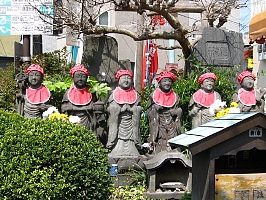
As you walk along the street that runs in front of Onari Elementary School (御成小学校) toward Yuigahama, you will reach Yuigahama-odori Avenue. On the left at the crossing, you will find a set of six stone statues of Jizo with red bibs around their necks, standing on pedestals on raised ground and surrounded by a low stone fence.
These six statues are called Roku Jizo--roku meaning six in Japanese--hence the name of this area.
It is said that in the Kamakura period there used to be an execution site slightly to the north of here. Later, the field was left uncultivated and called Kekachibatake (飢渇畠), "Starving-Field."
In time, the local people dedicated six Jizo here for the repose of the souls of the dead or executed. A stone marker explaining the origin of these Roku Jizo stands nearby.
The origin of Roku Jizo themselves, however, is beset with theories. The most probable one is that they are six manifestations of Jizo, each active in one of the six worlds where Jizo helps suffering people gain salvation.
The six worlds are the realms of hell (地獄), hungry spirits (餓鬼), animals (畜生), bellicose spirits (阿修羅), human beings (人間), and heaven (天). The souls of sentient beings are believed to transmigrate from one world to another.
Next to the Roku Jizo here is a small structure dedicated to Roku Jizo Inari (六地蔵稲荷).
| Wadazuka (和田塚) |
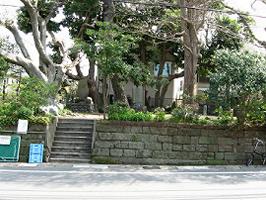
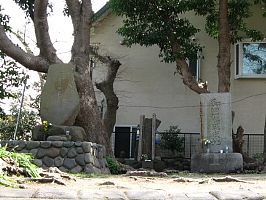
Soon after walking out of Wadazuka Station on the Enoden Line heading toward the beach, you will see a raised ground to the left dotted with old trees and surrounded by stone walls.
Within the grounds are some twenty stone stupas in gorinto-type (五輪塔) and a stone monument in the center.
This mound is popularly called Wadazuka, the "Wada Mound," since it is said to be the graveyard where members of the Wada clan (和田), influential vassals of the Kamakura period, were buried. More exactly, the mound was once called Mujodozuka (無常堂塚) and was one of the ancient burial mounds called Mukaibara Kofungun (向原古墳群, a cluster of Mukaihara Burial Mounds), which belonged to the Tumulus period (the third to seventh centuries).
When the mound was excavated in the Meiji period (1867-1912) due to road construction, many human bones were found buried together with haniwa (埴輪, tumulus figures) and fragments of earthenware. At the time, the bones were thought to be those of the Wada, who had fought against the Hojo (北条) and were defeated near here. It is from that time that the mound came to be called Wadazuka. Since this is the only tumulus mound that remains in Kamakura, it is thought to be very precious.
Wada Yoshimori (和田義盛, 1147-1213), a grandson of Miura Yoshiaki (三浦義明, 1092-1180) and military leader in the early part of the Kamakura period, pledged allegiance to Minamoto no Yoritomo (源頼朝, 1147-99) in the latter's uprising against the Taira (平) in 1180. Rewarded with the post of Administrator (別当, betto) of the Board of Retainers (Samuraidokoro, 侍所) for his help, Yoshimori became so influential that after the death of Yoritomo, the Hojo came to fear his popularity among the vassals of other clans and concocted a scheme to provoke Yoshimori into revolt.
When Yoshimori's sons and his relatives were arrested on charges of plotting against the Hojo, Yoshimori came all the way from Chiba and begged Shogun Minamoto no Sanetomo (源実朝, 1192-1219) to pardon them. This was done for his sons but one of his relatives was sent into exile. Angered at this decision, Yoshimori, with his sons and followers, attacked the residence of the Hojo.
The battle was fought everywhere in the city, continued for two days, and is known as Wada Gassen (和田合戦), "the Battle of the Wada." Although they put up a stiff resistance, the Wada were defeated near here and destroyed, having fallen into a trap set by the Hojo in the latter's process of dictatorship.
Diagonally across from the Wada Mound is the Kamakura-bori Kogeikan (鎌倉彫工芸館), where some one hundred Kamakura-bori works are on display: wooden boxes, bowls, trays, plates, hand mirrors, and so forth. The hall is open to public view and the articles are for sale or can be ordered. Videotapes in Japanese that show the carving and lacquering processes of Kamakura-bori can be watched on the premises.
| The Former Site of the Residence of Someya Tokitada (染谷時忠屋敷跡) |
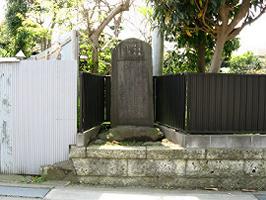
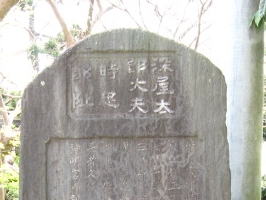
The monument, which marks this site, stands 150 meters from Yuigahama-odori on the street running in front of Yuigahama Station.
The explanation on the monument tells us that Tokitada was a descendant of Fujiwara no Kamatari (藤原鎌足, 614-669) and father of Ryoben (良弁), the priest who promoted the founding of Todaiji Temple in Nara.
Tokitada lived in Kamakura from the end of the seventh to the early eighth centuries. As a kind of constable, he oversaw the eight provinces of the Kanto region. He is said to have been very rich but, according to legend, his daughter met a tragic death. (See below)
| To no Tsuji (塔の辻) |
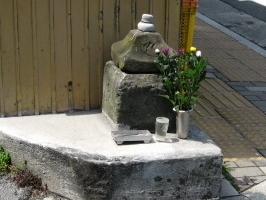
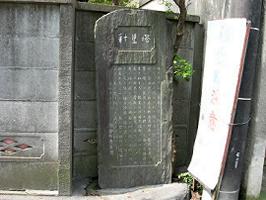
The area called To no Tsuji is located where the lane running from Sasuke crosses Yuigahama-odori. It got its name from the fact that there was a to (塔, pagoda) at the tsuji (辻, crossroads).
In olden days, it was customary to set stone monuments at crossroads. As might be expected, there are two stone stupas here. They are topped by red caps, as if they were stone figures, and offerings of flowers are made.
A local legend has it that one day the three-year-old daughter of Someya Tokitada was carried off by an eagle. Tokitada and his wife desperately sought for their lost child and wherever they found a part of her body, they erected a stone stupa. The stupa here is said to have been one of those erected in memory of their daughter.
A stone monument marking this tragedy now stands on the side of the lane leading toward Sasuke (佐助).
0 comments:
Post a Comment